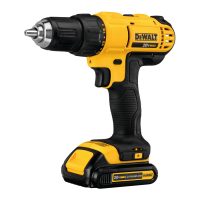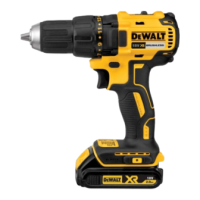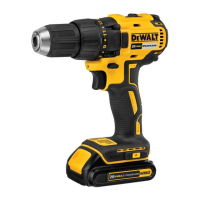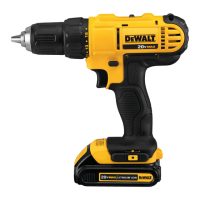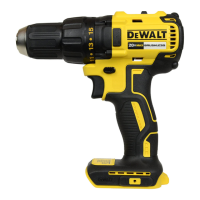ENGLISH
3
g ) Use the power tool, accessories and tool bits etc.
in accordance with these instructions, taking
into account the working conditions and the
work to be performed. Use of the power tool for
operations different from those intended could result
in a hazardoussituation.
h ) Keep handles and grasping surfaces dry, clean
and free from oil and grease. Slippery handles and
grasping surfaces do not allow for safe handling and
control of the tool in unexpected situations.
5) Battery Tool Use and Care
a ) Recharge only with the charger specified by the
manufacturer. A charger that is suitable for one type
of battery pack may create a risk of fire when used
with another batterypack.
b ) Use power tools only with specifically designated
battery packs. Use of any other battery packs may
create a risk of injury andfire.
c ) When battery pack is not in use, keep it away
from other metal objects, like paper clips, coins,
keys, nails, screws or other small metal objects,
that can make a connection from one terminal to
another. Shorting the battery terminals together may
cause burns or afire.
d ) Under abusive conditions, liquid may be ejected
from the battery; avoid contact. If contact
accidentally occurs, flush with water. If liquid
contacts eyes, additionally seek medical help.
Liquid ejected from the battery may cause irritation
orburns.
e ) Do not use a battery pack or tool that is
damaged or modified. Damaged or modified
batteries may exhibit unpredictable behavior resulting
in fire, explosion or risk of injury.
f ) Do not expose a battery pack or tool to
fire or excessive temperature. Exposure to
fire or temperature above 265 °F (130°C) may
causeexplosion.
g ) Follow all charging instructions and do not
charge the battery pack or tool outside the
temperature range specified in the instructions.
Charging improperly or at temperatures outside the
specified range may damage the battery and increase
the risk of fire.
6) Service
a ) Have your power tool serviced by a qualified
repair person using only identical replacement
parts. This will ensure that the safety of the power
tool is maintained.
b ) Never service damaged battery packs. Service
of battery packs should only be performed by the
manufacturer or authorized service providers.
Safety Instructions for All Operations
• Hold power tools by insulated gripping surfaces
when performing an operation where the cutting
accessory may contact hidden wiring. Cutting
accessories contacting a “live” wire may make exposed
metal parts of the power tool “live” and could give the
operator an electricshock.
Safety Instructions When Using Long
Drill Bits
• Never operate at higher speed than the maximum
speed rating of the drill bit. At higher speeds, the bit is
likely to bend if allowed to rotate freely without contacting
the workpiece, resulting in personal injury.
• Always start drilling at low speed and with the bit
tip in contact with the workpiece. At higher speeds,
the bit is likely to bend if allowed to rotate freely without
contacting the workpiece, resulting in personal injury.
• Apply pressure only in direct line with the bit and do
not apply excessive pressure. Bits can bend causing
breakage or loss of control, resulting in personal injury.
Additional Safety Warnings for Drills
• Use clamps or another practical way to secure and
support the work piece to a stable platform. Holding
the work by hand or against your body leaves it unstable
and may lead to loss of control.
• Do not operate this tool for long periods of time.
Vibration caused by the operating action of this tool may
cause permanent injury to fingers, hands, and arms. Use
gloves to provide extra cushion, take frequent rest periods,
and limit daily time of use.
• Hammer bits and tools get hot during operation.
Wear gloves when touching them.
WARNING: Shock hazard. When drilling or driving
into walls, floors or wherever live electrical wires
may be encountered, DO NOT TOUCH ANY METAL
PARTS OF THE TOOL! Hold the tool only by the plastic
handle(s) / housing to prevent shock.
• Do not lock the tool ON when drilling by hand.
• Hold drill firmly with both hands to control the
twisting action of the drill. If your drill is equipped with
a side handle, always use the sidehandle.
WARNING: Drill may stall (if overloaded or improperly
used) causing a twist. Always expect the stall. Grip the
drill firmly to control the twisting action and prevent
loss of control which could cause personal injury. If a
stall does occur, release the trigger immediately and
determine the reason for the stall before re-starting.
• Always remove the battery pack when attaching or
removing accessories. When attaching accessories in
the drill chuck, it is important to securely tighten the chuck
using all three holes to prevent slippage. When using a
keyless chuck, hand tighten firmly
Additional Safety Information
WARNING: Never modify the power tool or any part
of it. Damage or personal injury couldresult.
WARNING: ALWAYS use safety glasses. Everyday
eyeglasses are NOT safety glasses. Also use face or
dust mask if cutting operation is dusty. ALWAYS WEAR
CERTIFIED SAFETYEQUIPMENT:
• ANSI Z87.1 eye protection (CAN/CSA Z94.3),
• ANSI S12.6 (S3.19) hearing protection,
• NIOSH/OSHA/MSHA respiratoryprotection.
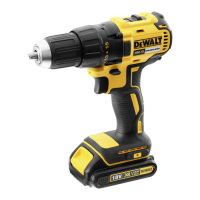
